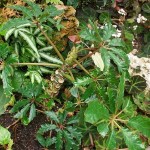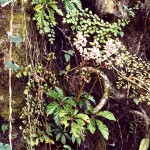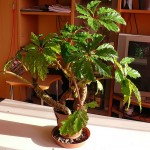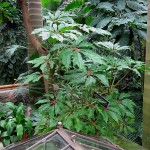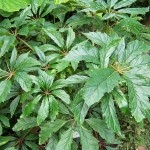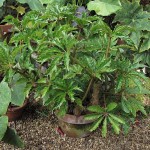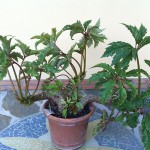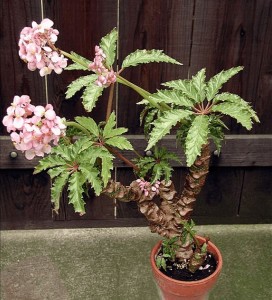Family: Begoniaceae
Synonymous: Gireoudia carolineifolia
Begonia rotata
Gireoudia rotata
Begonia carolineifolia (misspelling)
Distribution and habitat: Begonia caroliniifolia is a perennial evergreen rhizomes form of begonia native to Southern Mexico and Central America. In the wild, these plants often lean against tree trunks or rocks, sometimes grasping them with their wiry roots.
In moist forest on steep,rocky slopes at an altitude of 50-495m.
Description: Begonia caroliniifolia is an upright rhizomatous with a striking woody trunk with palmately compound leaves that look like palm fronds. This plant does not branch freely and becomes quite large when well-grown, up to 60-100cm (24-39 inch) high. The stem is exceptionally tick, bearing the scars of the felled off leaves. This swollen trunk-like stems sprout decorative frilly-edged palmate foliage each leaflet with its own petiole, dense heads of small pink flowers.
The digitate leaves are arranged alternate and the leaflets are lanceolate with undulate margins. The leaves are hairless above, with long rusty hairs beneath glossy green, 30-40cm (12-16 inch) in diameter and have long reddish stalks 1-2.7cm (0.8-1 inch) merging into leaf-blades and densely hairy. The stipules are large, ovate-acuminate with outer surface hairy.
The light-pink flowers with yellow hearts are an added boon to this already beautiful plant. Dichotomous cymes are bearing pink flowers. Elliptic, obtuse bracts with outer surface hairy are subtending only the male flowers. The male flowers are 6.7-9mm across with two rounded-obovate perianth segments and filaments that are slightly fused at base. Female flowers are smaller and have two perianth segments and three persistent styles. The flowers are produced in late winter and spring. The flowers regularly for at least three months and sometimes longer and are followed by loculicidal three celled capsules about 9mm diameter and unequally three winged.
Houseplant care: Begonia caroliniifolia is an easy to grow plant and it is highly decorative not only its foliage but also its flower add colour and beauty.
A winter rest time seems is beneficial for these plants.
Light:Begonia caroliniifolia needs bright light without direct sunlight. Plants grown under natural sunlight on a windowsill will often perform best when provided with a south facing position in winter and est-facing one in summer. Do not rotate Begonia caroliniifolia if it is in the windowsill as the delicate stalk may break as the flower tries to reorient towards the sunlight.
Plants grown in too dark location will result in unnaturally pale foliage that is stretched towards the brightest source light. However plants receiving too much light will often have pale, bleached leaves with dry brown margins.
Temperature: Normal room temperatures are suitable for actively growing Begonia caroliniifolia. Overwinter these plants at no less than 12C (55F). These plants need a constant temperature to flourish.
For increased humidity stand pots on trays of moist pebbles.
Watering: Water actively growingBegonia caroliniifolia plants moderately, allowing the top couple centimetres (0.8 inch) of the potting mixture to dry out before watering again. During the winter rest period water more sparingly, allowing the top half of the potting mixture to dry out between waterings. Use lukewarm water when watering these plants.
Feeding: Apply standard liquid fertiliser every two weeks to actively growing Begonia caroliniifolia plants. Do not apply fertiliser to newly repotted plants for about one month. Also do not fertilise sick or dormant plants because they are particularly susceptible to root damage.
Also remember that a soilless potting mixture will need more frequent fertiliser applications than most soil based potting mixtures.
Potting and repotting: Use either a peat-based mixture or a combination of equal parts of soil based potting mixture and coarse leaf mould. Place a shallow layer of clay-pot fragments in the bottom of pots for extra drainage.
Move theBegonia caroliniifolia plants into pots one size larger every spring until maximum convenient pot size has been reached probably 15-20cm (6-8 inch) . Thereafter, top-dress annually with fresh potting mixture.
When potting and repotting these plants, simply sprinkle some mixture around the roots and tap the container briskly to settle the mixture. Do not firm it down with the fingers.
Gardening:Begonia caroliniifolia tolerate temperatures only above at least 1C (34F). They are tender but very drought-proof. These plants make interesting subjects for containersor they grow well in the garden in areas with warm humid summers . Although they may be slow to establish.
Position: In warm sunny areas, Begonia caroliniifolia plants should not receive bright direct sunlight and light should be indirect (scattered off surrounding object) or filtered (by netting or trees). In northern regions this shading is often necessary during the spring and summer, but in fall and winter they will need far less shading.
Begonia caroliniifolia needs plenty of garden space (or a large tub) as it will spread its very large rhizomes over a considerable area.
Soil:Begonia caroliniifolia prefer a free draining, light and well aerated soil that tends towards being more acidic with a pH of around 5.5 to 6.5. If the soil is alkaline, add some sulphur to increase the acidity. To improve the drainage, add some compost or other organic matter when preparing the soil for these plants.
Use leaves to form a thick natural mulch layer around the plants that holds in the moisture and also breaks down to enrich the garden soil.
Irrigation: In the garden, water them deeply as required. They are succulent plants so they will accept quite dry conditions. Use tepid water to water these plants.
Water pot-grownBegonia caroliniifolia when the soil surface dries out test with fingertip to 2cm (0.8 inch) depth. When water the plant ensure that the pot is saturated, but do not allow them to stand in water.
Fertiliser: While Begonia caroliniifolia are actively growing they will benefit from a regular application of water soluble fertiliser containing a 20-10-20 mix of the three major plant macro-nutrients: nitrogen (N), phosphorus (P) and potassium (K). Always follow the instruction that come with the fertiliser. Overfertilising the plant can damage the roots.
Propagation: Begonia caroliniifolia can be propagated by rhizome cuttings which are similar with stem cuttings. Like other stem cuttings, use cutting with nodes. Rhizome cuttings can be made at any length. The rhizomes do not have to have leaves to root and grow. Tip cuttings from rhizomes can be rooted upright with the cut end stuck 1.2-2.5cm (0.5-1 inch) into the rooting medium. When using the tips of rhizomes remove the largest leaves as they will probably fall off during rooting anyway. Dip the cut rhizome in hormone rooting powder. Plant it in a 8cm (3 inch) pot of a moistened equal-parts mixture of peat moss and coarse sand or perlite. Make sure the rhizome has good contact with the rooting medium but not buried more than half way. Enclose the new planted rhizome in a plastic bag or propagating case. Stand it in bright filtered light until renewed growth indicates that rooting has occurred. Uncover the rooted plant and begin to water it sparingly and to apply standard liquid fertiliser about once every two weeks. Do not overwater to avoid rotting. About six months after the start of propagation, move the young plant into a slightly larger pot of standard potting mixture and treat it as a mature plant. Using this method of propagation it is obtained a new plant faster.
Propagation from seed: The seeds are very tiny and should be not buried when sown. Mix them with little fine sand before sowing. Sow seeds trays in any standard germination medium (equal parts of peat and perlite or equal parts of vermiculite and perlite). A light mist spray of the surface will settle the seeds adequately. Keep the propagating trays in warm, moist conditions (intermittent mist ideal) in bright light, but no direct sun.
Prick the seedlings out into individual cells or small pots 6-8cm (2.5-3inch) when the first three leaves are formed. Use same potting mixture as for mature plants. The seedlings benefit from dilute applications of soluble fertiliser every two weeks. Re-potting will be necessary in about six months or so. Pot the new plants in pots one size larger when the root ball fill the pot. Thereafter treat them as mature Begonia caroliniifolia.
Problems:
Mealy bug can be a common pest of Begonia caroliniifolia plants.
Treatment: If infestation is localized, remove insects by wiping affected areas with a cotton swab dipped in rubbing alcohol or dipping the plant in a solution of soapy water and alcohol.
A number of tiny mite species can be problematic for Begonia caroliniifolia. Infested leaves are yellow speckled and, if the infection is severe, may be covered with wool like substance on their undersurface.
Treatment: Control these mites with a suitable acaricide.
There are two kinds of microscopic, worm-like creatures parasite to Begonia caroliniifolia plants: leaf nematodes and root nematodes.
Treatment: The best form to control is to destroy affected plants. In open garden avoid replanting begonias in contaminated soil. In case of potted plants, infestation may be prevented ans controlled by routinely using sterilized potting mixtures and washing the plant pots.
Scale insects may feed on Begonia caroliniifolia plants.
Treatment: If infestation is localized, remove insects by wiping affected areas with a cotton swab dipped in rubbing alcohol or dipping the plant in a solution of soapy water and alcohol.
Slags and snails are a problem in open garden.
Treatment: These pests are controlled using an appropriate molluscicide, both pellet and liquid forms or by hand pick at regular inspections.
Both the adults ans larvae of two kinds of weevils feed on Begonia caroliniifolia.
Treatment: Insecticides are capable of controlling these insects, but if they are inside the cavities of the plants, they will not be killed. To fully exterminate them, systemic insecticide are needed.
Whiteflies infest the under-surface of the uppermost leaves and if disturbed fly rapidly around the top of the host plants.
Treatment: Successive sprays of insecticidal soaps or white oil will eradicate whiteflies infestations. Coverage of leaf undersides is important.
Bacterial leaf spot will produce water-soaked areas on the leaves that are surrounded by yellow rings. It may cause leaf drop and, in some cases, associated stem rot may occur.
Treatment: Once the disease is present, remove and destroy any affected leaves or stems and spray the plants with a bacterial leaf spot treatment.
Botrytis blight will produce gray moldy patches on leaves, stems and duds.
Treatment: This disease can be managed by improving the air circulation and plant hygiene by removing and destroying dead and dying leaves ans flowers. Use a suitable fungicide.
Powdery mildews produce unsightly white powdery patches on leaves, stems and buds.
Treatment: Manage this disease by restricting watering to morning so that water unwillingly splashed on leaves will quickly evaporate. Improve the air circulation around the plants. Severe cases may be treated with adequate fungicide.
Pythium rot root attacks the roots and stem bases of adult plants and cuttings. Affected plants at first will have a slightly wilted appearance, followed by yellowing their lower leaves. As the disease progress, the roots and stems turn black and musky, leading to the death of the plant.
Treatment: The use of sterilized potting mixture and use of appropriate fungicide will control this disease.
Rhizoctonia crown rot will be detected by the presents of brownish mould spreading from the soil to the infected stem base, a condition that will eventually lead to the collapse and death of the stem. This fungal disease appear only on plants that have been damaged or stressed by high temperatures or poor growing conditions.
Treatment: Maintenance of hygienic conditions and good cultural practice should prevent fungal growth. Fungicide sprays are also available.
A variety of viral diseases can attack Begonia caroliniifolia plants causing symptoms like yellowing the leaves, pale yellow rings or spots, leaf malformation and stunted growth.
Treatment: Always use sterile potting mixture and treat insect infestations to prevent viral disease. Destroy all affected plants.
Uses and display:Begonia caroliniifolia is striking as a house plant and surely just as much an eye-catcher in your terrarium or as a exotic plant at home. It makes an excellent feature plant for any garden scheme. This distinctive and dramatic plant features large, light green compound leaves and an upright growing. It is an unusual specimens within its genus.
SUMMARY:
CHARACTERISTICS:
Foliage green
Shape upright
Height: 60-100cm (24-39 inch)
PROPER CARE:
Watering in rest period moderately
Watering in active growth period moderately
Light bight filtered
Temperature in rest period min 12oC max 16oC (55-60oF)
Temperature in active growth period min 16oC max 27oC (61-81oF)
Humidity moderate
Hardiness zone 10a-11
